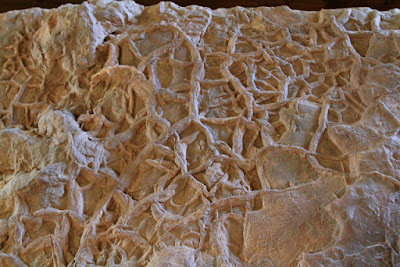Friday, December 8, 2017
RonnieAdventure #0285 - St. George (Utah) and Vicinity (2017 Part I)
The St. George Historic District (primarily located between 100 East and 100 West, north of 100 South) is an interesting place to spend an afternoon. There are historic buildings, parks and gardens, boutique shops, and many beautiful works of art in the downtown area. The historic Mormon Tabernacle, known as the "Jewel in the Desert," is currently surrounded by scaffolding because it is undergoing an extensive restoration
Construction started on the Tabernacle in 1863 and it took 12 years before the building was completed. The three foot thick basement walls were hand-quarried from a limestone quarry near the city and the two-and-a-half-foot-thick red sandstone building walls were hand-quarried from a site near the present day Red Hills Golf Course. Chisel marks are still visible on the building walls. Wood trusses for the building were hand-hewn from timber logged near Pine Valley and transported to St. George by horse-drawn wagon teams. The building's clock was made in London and when installed on the front of the building it became the "official" city time, which alleviated many disputes over irrigation watering times that were set to the nearest minute due to the scarcity of water in the area.
Located at the corner of Main and 200 North is the St. George Social Hall that was constructed in 1875 and expanded in 1880 to host dances, theatrical performances and musicals, public meetings, and classes. When operettas became popular, the building's name was changed to the St. George Opera House. The building is still in use today.
The Washington County Historic Adobe House is a one-room structure built about 1880 and once housed a family of six members. In 1997 the house was moved from its original location to a site near the Opera House.
Art Around the Corner is a not-for-profit organization that is the major force behind public art in St. George. The organization provides a free Walking Guide for the Historic Distinct and will provide free tours upon request. Included in the Walking Guide is a map of the downtown area with sculpture names and locations noted on the map. The sculptures consist of a permanent sculpture collection and temporary art pieces that are typically for sale.
The Bison is the mascot for the Dixie State University Trailblazers; so there are painted Bison not only in the historic district, but pained Bison can also be found at various locations around town.
The temporary sculptures tend to be more modernistic in design.
The Rosenbruch Wildlife Museum has over 300 animals on display from around, which are exhibited in a two-story 33,000 square foot building. Personal hand-held electronic wands provide explanations of the various species at each diorama. The museum works closely with the local school system and provides a number of educational programs for students. Throughout the museum there are signs with a quote that I like: "We do not inherit the Earth from our ancestors. We borrow it from our children."
In 2000, Dr. Johnson was leveling a hill on his property in St. George when he encountered a thick layer of sandstone. As he was breaking the sandstone into large blocks, he discovered the first of thousands of dinosaur tracks that were formed in mud about 200 million years ago. Dr. Johnson realized that the tracks should be preserved and maintained for scientific purposes, so the Johnson Family set up a foundation and museum on the site "...as a creative learning environment that challenges, enlightens, and entertains the minds of those who visit."
One of the more interesting things that we discovered while touring the museum was evidence that humans have traveled back in time. (Note the DeLorean DMC-12 time machine from the movie Back to the Future in the upper left corner.)
Subscribe to:
Post Comments (Atom)





















































No comments:
Post a Comment